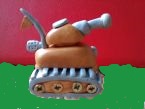Neilster
Posts: 2890
Joined: 10/27/2003
From: Hobart, Tasmania, Australia
Status: offline

|
quote:
ORIGINAL: warspite1
quote:
ORIGINAL: Neilster
quote:
ORIGINAL: warspite1
quote:
ORIGINAL: Neilster
quote:
In 1943-1944 Germany made tens thousands AFVs in a year when air bombings and material shortages began. Before that it was the same as before the war
I have demonstrated to you that this is not the case.
https://en.wikipedia.org/wiki/German_armored_fighting_vehicle_production_during_World_War_II
German AFV production in WW2
1939: 370
1940: 1,888
1941: 3,623
1942: 5,530
1943: 11,601
1944: 18,956
1945: 4,406
These figures are completely at odds with your assertion.
Cheers, Neilster
warspite1
Not sure of the Wiki source for that, but The World War II Database (Ellis) comes up with pretty similar figures - 12,000 in 1943 and 19,000 in 1944.
Maybe those insisting on 'tens of thousands' are inadvertently including trucks and lorries?? According to Ellis these numbered 74,000 in 1943 and 67,000 in 1944.
quote:
Before that it was the same as before the war
The point is the Germans didn't keep production at about pre-war levels and then suddenly went mad in 1943/44. There was a clear acceleration from the beginning of the war onwards. The story for aircraft production is similar.
Cheers, Neilster
warspite1
I completely agree - that is nonsense. Oberst Adolf von Schell was trying to drag German vehicle production up in the late 30's. One of the amazing things about Germany was the vehicle per head nos. (which of course was key when trying to re-arm).
- Italy 1 car for every 104 people
- UK 1 in 14
- USA almost 1 in 3
- Germany 1 in 47
So what? Well think about the knock-on effects - less drivers for the army, less mechanics, less repair shops, less production facilities. Shiny new factories don't just happen overnight.
Yes. One of the problems the expanding Heer had was training enough drivers. With all Germany's pre-war problems, cars, and hence people who could drive, were relatively rare. As your figures show, cars were almost a luxury item outside the U.S. until the 1950s.
To give an Australian example, the first indigenously manufactured car here was the FX Holden in 1948. From memory these cost about two years' median wages, or about US$100,000 in today's money. For that, you got an engine, manual transmission, wheels, chassis, bodywork, seats and not much else.
As a result, someone getting a new car at the time was a really big deal, as my parents will attest. Britain, desperately short of money after the war, exported 90% of the cars they made until deep into the 50s. Owning one there then was unusual. It was for the well off and doctors.
Cheers, Neilster
|
 Printable Version
Printable Version

















 New Messages
New Messages No New Messages
No New Messages Hot Topic w/ New Messages
Hot Topic w/ New Messages Hot Topic w/o New Messages
Hot Topic w/o New Messages Locked w/ New Messages
Locked w/ New Messages Locked w/o New Messages
Locked w/o New Messages Post New Thread
Post New Thread